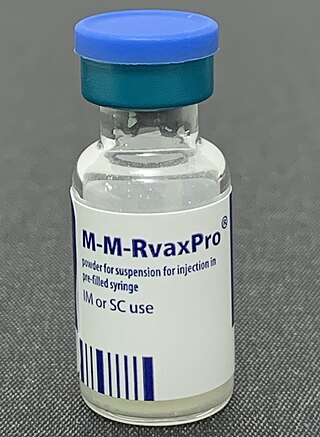
Measles is a highly contagious infectious disease caused by measles virus. Symptoms usually develop 10–12 days after exposure to an infected person and last 7–10 days. Initial symptoms typically include fever, often greater than 40 °C (104 °F), cough, runny nose, and inflamed eyes. Small white spots known as Koplik's spots may form inside the mouth two or three days after the start of symptoms. A red, flat rash which usually starts on the face and then spreads to the rest of the body typically begins three to five days after the start of symptoms. Common complications include diarrhea, middle ear infection (7%), and pneumonia (6%). These occur in part due to measles-induced immunosuppression. Less commonly seizures, blindness, or inflammation of the brain may occur. Other names include morbilli, rubeola, red measles, and English measles. Both rubella, also known as German measles, and roseola are different diseases caused by unrelated viruses.

The MMR vaccine is a vaccine against measles, mumps, and rubella, abbreviated as MMR. The first dose is generally given to children around 9 months to 15 months of age, with a second dose at 15 months to 6 years of age, with at least four weeks between the doses. After two doses, 97% of people are protected against measles, 88% against mumps, and at least 97% against rubella. The vaccine is also recommended for those who do not have evidence of immunity, those with well-controlled HIV/AIDS, and within 72 hours of exposure to measles among those who are incompletely immunized. It is given by injection.

Rubella, also known as German measles or three-day measles, is an infection caused by the rubella virus. This disease is often mild, with half of people not realizing that they are infected. A rash may start around two weeks after exposure and last for three days. It usually starts on the face and spreads to the rest of the body. The rash is sometimes itchy and is not as bright as that of measles. Swollen lymph nodes are common and may last a few weeks. A fever, sore throat, and fatigue may also occur. Joint pain is common in adults. Complications may include bleeding problems, testicular swelling, encephalitis, and inflammation of nerves. Infection during early pregnancy may result in a miscarriage or a child born with congenital rubella syndrome (CRS). Symptoms of CRS manifest as problems with the eyes such as cataracts, deafness, as well as affecting the heart and brain. Problems are rare after the 20th week of pregnancy.

Congenital rubella infection (CRI) occurs when a fetus contracts the rubella virus via maternal-fetal transmission. It can result in various outcomes ranging from asymptomatic infection to congenital defects to miscarriage and fetal death. Congenital rubella syndrome (CRS) refers to a congenital rubella infection that results in various presentations of birth anomalies. If infection occurs 0–11 weeks after conception, the infant has a 90% risk of being affected. If the infection occurs 12–20 weeks after conception, the risk is 20%. Infants are not generally affected if rubella is contracted during the third trimester. Congenital rubella syndrome was discovered in 1941 by Australian Norman McAlister Gregg.

The Battle of Fort Stedman, also known as the Battle of Hare's Hill, was fought on March 25, 1865, during the final weeks of the American Civil War. The Union Army fortification in the siege lines around Petersburg, Virginia, was attacked in a pre-dawn Confederate assault by troops led by Maj. Gen. John B. Gordon. The attack was the last serious attempt by Confederate troops to break the Siege of Petersburg. After an initial success, Gordon's men were driven back by Union troops of the IX Corps commanded by Maj. Gen. John G. Parke.
The MMRV vaccine combines the attenuated virus MMR vaccine with the addition of the chickenpox vaccine or varicella vaccine. The MMRV vaccine is typically given to children between one and two years of age.

Sir William Schwenck Gilbert was an English dramatist, librettist, poet and illustrator best known for his collaboration with composer Arthur Sullivan, which produced fourteen comic operas. The most famous of these include H.M.S. Pinafore, The Pirates of Penzance and one of the most frequently performed works in the history of musical theatre, The Mikado. The popularity of these works was supported for over a century by year-round performances of them, in Britain and abroad, by the repertory company that Gilbert, Sullivan and their producer Richard D'Oyly Carte founded, the D'Oyly Carte Opera Company. These Savoy operas are still frequently performed in the English-speaking world and beyond.
The Dupuit–Forchheimer assumption holds that groundwater flows horizontally in an unconfined aquifer and that the groundwater discharge is proportional to the saturated aquifer thickness. It was formulated by Jules Dupuit and Philipp Forchheimer in the late 1800s to simplify groundwater flow equations for analytical solutions.
An attenuated vaccine is a vaccine created by reducing the virulence of a pathogen, but still keeping it viable. Attenuation takes an infectious agent and alters it so that it becomes harmless or less virulent. These vaccines contrast to those produced by "killing" the virus.
Philipp Forchheimer was an Austrian engineer, a pioneer in the field of civil engineering and practical hydraulics, who also contributed to the archaeological study of Byzantine water supply systems. He was professor in Istanbul, Aachen and Graz.

Measles vaccine protects against becoming infected with measles. Nearly all of those who do not develop immunity after a single dose develop it after a second dose. When rate of vaccination within a population is greater than 92%, outbreaks of measles typically no longer occur; however, they may occur again if the rate of vaccination decrease. The vaccine's effectiveness lasts many years. It is unclear if it becomes less effective over time. The vaccine may also protect against measles if given within a couple of days after exposure to measles.

Rubella vaccine is a vaccine used to prevent rubella. Effectiveness begins about two weeks after a single dose and around 95% of people become immune. Countries with high rates of immunization no longer see cases of rubella or congenital rubella syndrome. When there is a low level of childhood immunization in a population it is possible for rates of congenital rubella to increase as more women make it to child-bearing age without either vaccination or exposure to the disease. Therefore, it is important for more than 80% of people to be vaccinated. By introducing rubella containing vaccines, rubella has been eradicated in 81 nations, as of mid-2020.

Blueberry muffin baby, also known as extramedullary hematopoiesis, describes a newborn baby with multiple purpura, associated with several non-cancerous and cancerous conditions in which extra blood is produced in the skin. The bumps range from 1-7mm, do not blanche and have a tendency to occur on the head, neck and trunk. They often fade by 3 to 6 weeks after birth, leaving brownish marks. When due to a cancer, the bumps tend to be fewer, firmer and larger.

Frederick Forchheimer (1853–1913) was an American pediatrician known for describing Forchheimer spots.
Congenital cutaneous candidiasis is a type of candida infection in newborn babies, which appears as generalized red patches and small bumps on the skin or in the mouth, appearing at birth or a few days after birth. It can also occur as more serious widespread disseminated type.
Boston exanthem disease is a cutaneous condition that first occurred as an epidemic in Boston in 1951. It is caused by echovirus 16. The disease tends to afflict children more often than adults, although some adults can become infected, and the symptoms have never been fatal. It shows some clinical similarity to Rubella and Human herpesvirus 6
The Luftwaffe, from its founding in 1933 to the end of World War II in 1945, used ranks similar to other air forces at the time; however, some Luftwaffe ranks had no equivalent in the Allied air forces. While many ranks might have equivalents in other air forces, in reality the Luftwaffe military had a far greater responsibility; while officers of the Royal Air Force, the British Air Force, were graded to a higher rank when performing higher rank functions, Luftwaffe officers maintained their rank while performing functions, regardless of size of the responsibility assigned to them.
Geoffrey Ernest Stedman is a New Zealand physicist, with research interests including the foundations of relativity, symmetry in quantum mechanics, and ring lasers.

Visage SDK is a multi-platform software development kit (SDK) created by Visage Technologies AB. Visage|SDK allows software programmers to build facial motion capture and eye tracking applications.
Forchheimer is a German surname that may refer to










